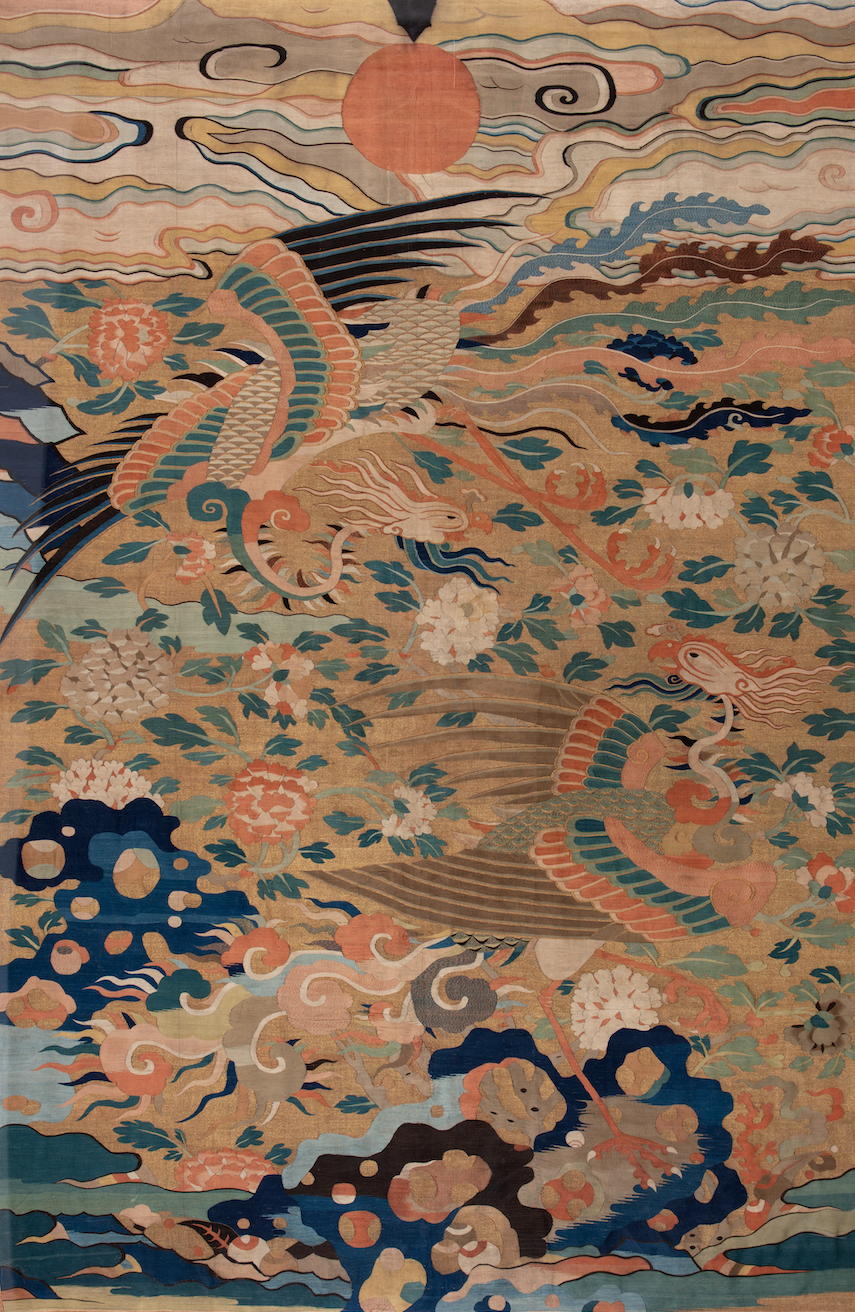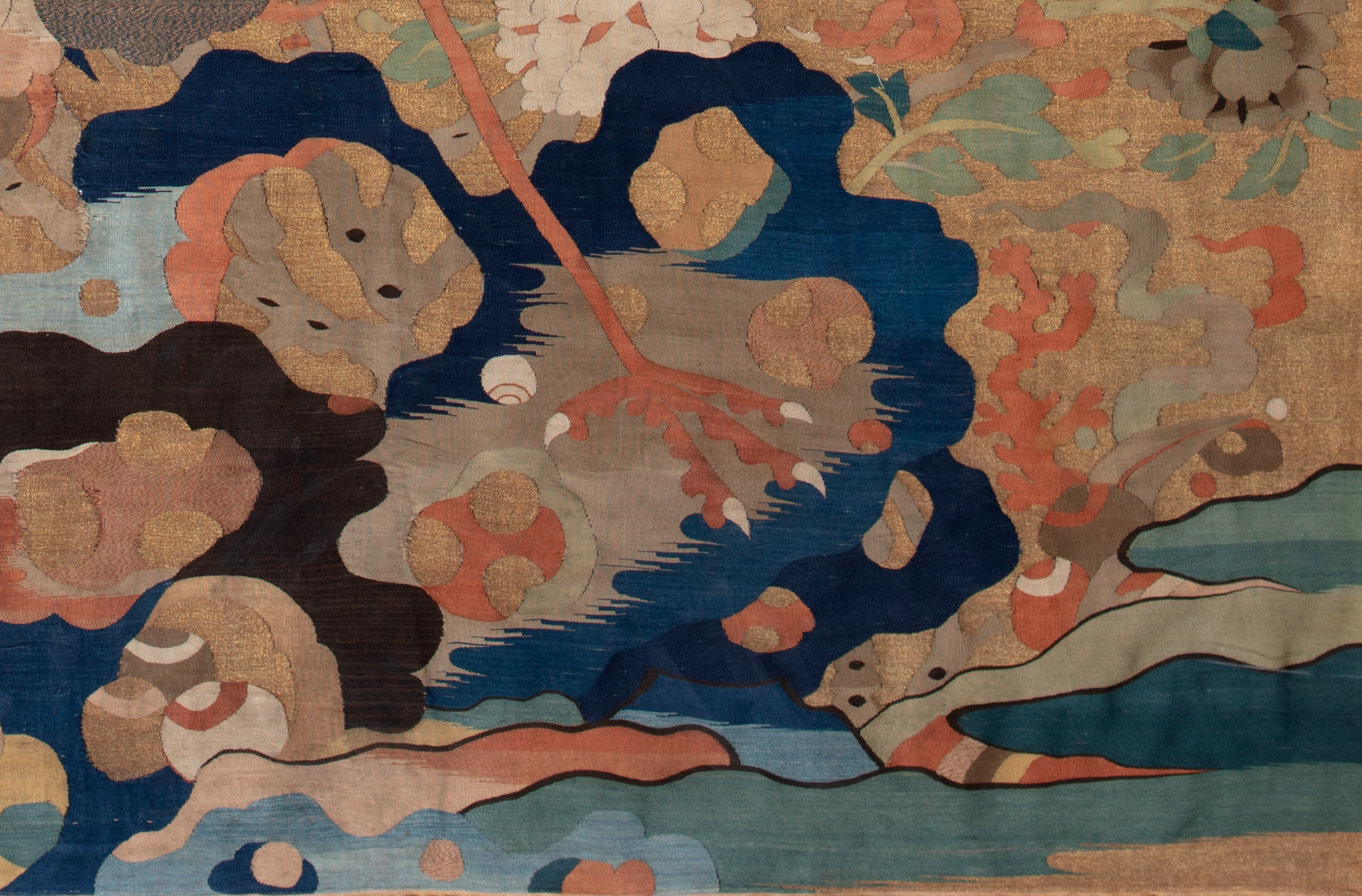Phoenixes Among Peonies: A Chinese Tapestry ‘Kesi’
Despite how it may appear, the Silk Tapestry Weave Hanging (2005.5.413) from the Mactaggart Art Collection depicting a pair of phoenixes in a peony garden, is not a painting. It is because of this painting-like quality that this textile exemplifies the exquisite craftsmanship of Ming and Qing Chinese artisans.
Chinese tapestry is a weaving technique made from white silk warp yarns (in the vertical position on a loom) interlaced with multi-coloured filling yarns (or wefts) to create a colourful pattern. Artisans, working section-by-section, repeatedly change the weft yarns according to the colours in the pattern. Between each coloured section the different coloured weft yarns do not twist around each other, but rather leave small slits that are only connected by the white warp yarns. The slit gives the appearance of a cut on the surface of the woven fabric, giving tapestry the name “carved silk” (kesi in Mandarin).
The Silk Tapestry Weave Hanging (Figure 1) features a pair of phoenixes gazing affectionately at one another. Each bird has a large, squinted eye, red-hooked beak, crown, and rippled mane connected to a long, slim, curved neck. The birds’ bodies are adorned with scale-like feathers and they have multi-coloured wings. The male phoenix (feng) is flying above the female (huang), who is standing on a rock. The male phoenix has five long serrated tail feathers and the female phoenix has curling tail feathers. The colour of their tails was made by twisting two colours of silk together, creating depth and movement. Chinese culture creates mythological phoenixes superior over the birds and gives them the auspicious symbol. A pair of phoenixes may represent the relationship between a husband and wife.
These phoenixes rest in a garden with large, colourful peony blossoms and scholar’s rocks.These hollowed rocks are naturally shaped by water, favoured by scholars, and are popular in Chinese gardening.1 The tapestry has an orange sun that shines over the garden against a background of moving clouds. These layers of colourful clouds, with curves and spirals, are typical styles found on textiles made during the Ming dynasty.
Along the lower edge of the tapestry, there are several treasure balls scattered among the rocks (Figure 2). Visible because of the circular band around the top, these balls are auspicious ornaments that represent wealth. In the archeological report Dingling2, among the textile excavations from Emperor Wanli's (1563-1620) mausoleum, a similar treasure ball motif was found on some textile designs. Therefore, the creation of this tapestry could be dated around the late Ming dynasty or the late 16th to early 17th centuries.
According to provenance records, the Silk Tapestry Weave Hanging originally hung as a canopy in a Tibetan monastery. The abbot sold this tapestry and other silks to collect money to build a Llamasary in San Francisco after his own Tibetan monastery burned to the ground. This tapestry is one of the best examples of kesi in the Mactaggart Art Collection.
1 “Collecting Guide: Scholars' Rocks: Christie's,” Scholar's rocks: a collecting guide | Christie's (Christie's, November 23, 2015), https://www.christies.com/features/Collecting-Guide-Scholars-Rocks-6815-1.aspx.
2 Institute of Archeology, Chinese Academy of Social Science, Dingling Museum, and Beijing Cultural Relics Work Team, Ding Ling, See Figure 85(E) Illustration for W270, Gold dragon brocade yardage, Beijing: Cultural Relics Publishing House, 1990.

